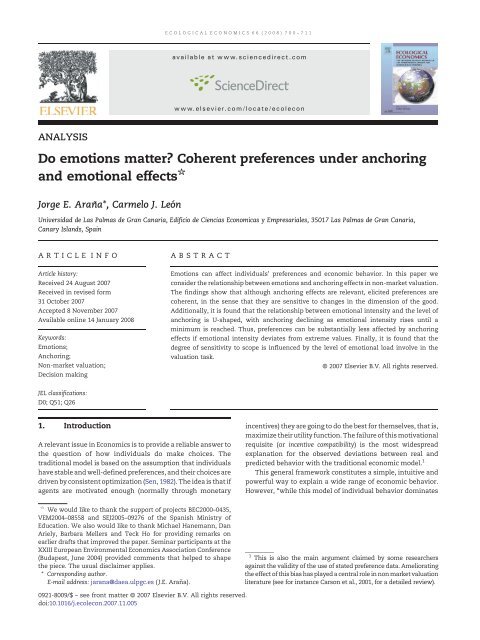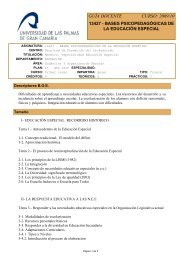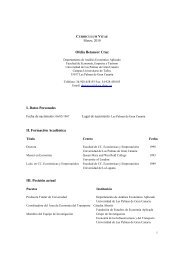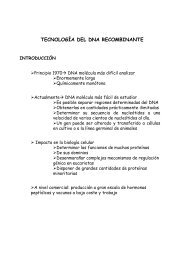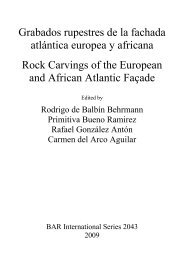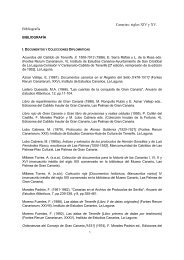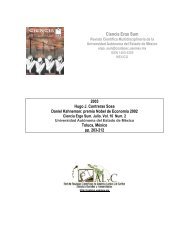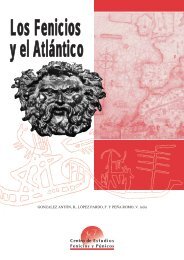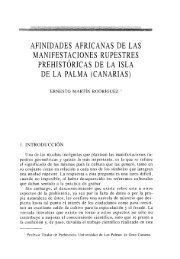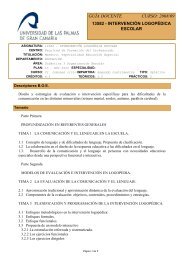Do emotions matter? Coherent preferences under anchoring and ...
Do emotions matter? Coherent preferences under anchoring and ...
Do emotions matter? Coherent preferences under anchoring and ...
You also want an ePaper? Increase the reach of your titles
YUMPU automatically turns print PDFs into web optimized ePapers that Google loves.
702 ECOLOGICAL ECONOMICS 66 (2008) 700– 711Section 4 discusses the results regarding the hypotheses of therelationships between the emotional load facing the individualin the valuation task <strong>and</strong> the degrees of <strong>anchoring</strong> <strong>and</strong> scopeeffects, as well as the relationships between <strong>anchoring</strong> <strong>and</strong>scope effects. Finally, Section 5 summarizes the main findings ofthe paper <strong>and</strong> sets up some of the implications for furtherresearch.2. Experimental design2.1. The good to be valuedThe application focused on the valuation of the rehabilitation ofa network of walking paths in the isl<strong>and</strong> of Gran Canaria, Spain.The network is an ancient infrastructure which was used inprevious centuries for communications between villages. Inrecent times, these paths have been ab<strong>and</strong>oned <strong>and</strong> new roadshave been built using modern techniques, at times replacing theold paths. The ancient path structure was mainly used forwalking, although it also could allow carriage <strong>and</strong> animalstransit in many parts of the network. The extension of thenetwork is about 1000 km. In the last years rehabilitation workhas been accomplished on 300 km using European funds.The rehabilitated network is currently used by the localpopulation <strong>and</strong> also by some tourists <strong>and</strong> visitors for hiking <strong>and</strong>walking. Due to its rural origin, most paths go through naturalareas <strong>and</strong> allow users to enjoy nature <strong>and</strong> magnificent l<strong>and</strong>scapes.The primary objective of the study was to determinehow much would be the benefits for the resident population ofthe isl<strong>and</strong> to be obtained from the expansion of the rehabilitatednetwork. The old ab<strong>and</strong>oned paths are practically impenetrable,thus the expansion of the services of the network requiresrebuilding more routes. All the construction techniques havebeen done following the old traditions <strong>and</strong> involving the originalmaterials, <strong>and</strong> were supposed to continue to be so for theexpansion of the network. 72.2. The computer-based questionnaireUsing the taxonomy proposed by Harrison <strong>and</strong> List (2004) ourstudy is defined as an artefactual field experiment. The datacollection was conducted in 2002 to the resident population ofGran Canaria. The questionnaire was administered viapersonal interviews at the subject's home. The interviewswere conducted by professional interviewers of a survey firm,previously trained by the authors to st<strong>and</strong>ardize surveyenvironment <strong>and</strong> subject attention. The interviews weresupported by a computer-based questionnaire implementedon personal laptops computers. The computer-based surveyinstrument, while holds most of the desirable characteristicsof lab experiments (e.g. control of the environment), hasseveral advantages over the alternatives: it can reduce sampleselection bias commonly observed in lab experiments, reduceinterviewer bias effects, allow the consideration of additional7 For more up to date information regarding conservation ofwalking paths in Gran Canaria you can visit: http://www.grancanaria.com/patronato_turismo/1860.0.html.covariates, <strong>and</strong> potentially permit improvements in thestatistical design. 82.3. The designA sample of households was r<strong>and</strong>omly screened from thecensus population of Gran Canaria published by the CanaryIsl<strong>and</strong>s Statistical Institute (ISTAC). The interviewers participatedactively in several training sessions on the specifics ofthe questionnaire. They did work also for the pre-test surveys,providing comments <strong>and</strong> suggestions for improving the finalquestionnaire. Up to three focus groups of 5–10 subjects <strong>and</strong>three pre-tests of 20–30 subjects were needed in order to reachthe final version of the survey instrument. In the process ofsuccessive revision of the pre-test questionnaires we consideredcritical issues such as the payment vehicle, the good tobe valued <strong>and</strong> the information content of the market design.The number of valid interviews was 574, with a response rateof approximately 84%.The survey instrument implemented the constructed marketaimed at valuing in monetary terms the benefits that thepopulation would enjoy from the expansion of the network. Thequestionnaire was structured in three main parts. The first partasked questions about the relative importance of a range ofobjectives of public policy in general, <strong>and</strong> recorded informationon the various recreational activities that the subject made inleisure time. These questions preceded the presentation of theelements of the market scenario <strong>and</strong> were intended to introducethe subject to the valuation context. The second sectionpresented the valuation scenario <strong>and</strong> asked the subject'swillingness to pay for the proposed policy. The policy proposalwas presented by a descriptive paragraph, <strong>and</strong> by means of aninteractive map on the computer, showing simulated pictures<strong>and</strong> drawings. The final section obtained information onsocioeconomic variables such as employment status, educationlevel, income level, family size, <strong>and</strong> year of birth.Key elements of the scenario are the payment vehicle, theelicitation method <strong>and</strong> the provision rule. The elicitationmethod was the double-bounded dichotomous choice basedon a bid design of alternative prices that were r<strong>and</strong>omlydistributed across the sample. Each individual in the sampler<strong>and</strong>omly received one of the several initial prices. The bidvector was designed utilizing Cooper's (1993) methods for apredetermined number of bids <strong>and</strong> based on the informationprovided by an open ended pre-test question. A second followupbid vector was defined by the next successive price in theinitial bid vector with an upper <strong>and</strong> a lower limit equallyspanned. If the individual answered ‘yes’ to the first price, thisprice was increased; if the answer to the first price wasnegative then the price were lowered. The final elicitation treeis presented in Fig. 1.8 As it was noted by a reviewer, in contexts in which the use ofcomputers is restricted to some portion of the population(normally younger <strong>and</strong> more educated people), the use ofcomputer-based questionnaires may invoke some selection bias.In this study, this potential issue was tested by employinginformation obtained in pilot surveys <strong>and</strong> focus groups. Thisanalysis found no selection bias effect.
ECOLOGICAL ECONOMICS 66 (2008) 700– 711703Fig. 1 – DBDC structure.The payment vehicle was a contribution to a special fundfor the specific purpose of carrying out the expansion of thewalking paths network. In order to enhance the incentivecompatibility of the payment vehicle we tested alternativeprovision rules in the initial stages of the study (i.e. focus groups,in-depth surveys <strong>and</strong> pilot surveys). The most satisfactoryoption was to follow a wording structure similar to the oneproposed in Rondeau et al. (1999) <strong>and</strong> Poe et al. (2002). This
ECOLOGICAL ECONOMICS 66 (2008) 700– 711705model with <strong>anchoring</strong> effects that allows us to consider theinterdependencies between the stages in the elicitation process.That is,WTP 1 i¼ A 1 iþ e 1 iWTP 2 i¼ A 2 iþ g i B 1 iþ e 2 iwith g i a½0; 1Š 8i; i ¼ 1; 2;:::nwhere μ i k =α i k +x i k β k (k=1,2) are the linear predictors associatedwith l×1 regression parameter vectors β k <strong>and</strong> covariate vectorsx i k , α i k is the intercept term, <strong>and</strong> η i captures the potential existenceof an anchor effect of the first bid on WTP of individual i(Herriges <strong>and</strong> Shogren, 1996). The linear predictors are linked tothe probability of a positive response by a bivariate normalcumulative distribution (BVN) called the link function. Simultaneitybetween responses is captured by the lower triangle componentof Σ (e.g. σ 2,1 ). This is a model of simultaneous equationswith limited dependent variables (SLDV), which reduces to ageneral triangular system (Zellner, 1971) for complete data sets.3.1. Inconsistency in elicited <strong>preferences</strong> between answers13 Alternatively, it would allow us to increase the precision of theestimates (lower variance) holding sample size constant.14 The inconsistency between first <strong>and</strong> second responses leads tothe rejection of the maintained assumption of the restricteddouble bounded model (Hanemann et al. 1991) that the mean <strong>and</strong>variances are constant across both bounds, <strong>and</strong> that the correlationcoefficient between the st<strong>and</strong>ard errors is equal to one,which essentially means that WTP i 1 =WTP i 2 . The rejection of thishypothesis implies a reduction in the efficiency gains of thedouble bounded elicitation procedure.15 The number of bounds can be increased successively in theelicitation process, leading to what has been denominated thetriple bounded dichotomous choice model (Langford et al. (1996).Cooper <strong>and</strong> Hanemann (1995) <strong>and</strong> Scarpa <strong>and</strong> Bateman (2000)showed that the efficiency gains are likely to diminish when thenumber of binary steps in the elicitation process is increased.ð1ÞThe main advantage of DBDC over SBDC is that the formerprovides more information on individual's <strong>preferences</strong>. Hanemannet al. (1991) showed that it leads to more efficient welfareestimates. This additional information may potentially allowthe researcher to conduct studies at a lower cost (smaller samplesizes) while holding the precision of the WTP estimates constant(same variance). 13 However, the DBDC has been questionedbecause of the empirical support to the argument that thedistribution of WTP is incoherent between both steps (e.g. Greenet al., 1998; Cameron <strong>and</strong> Quiggin, 1994). 14 In other words, themean or median WTP estimated using responses to the firstvaluation question differs empirically from the one estimatedusing the responses to the second question. 15The presence of potential behavioral responses to the followupquestion has been argued in non-market valuation as theprimary explanation of the incoherency between DBDC <strong>and</strong>SBDC (Alberini, 1995; Carson et al., 2001; Burton et al., 2003;DeShazo, 2002; Bateman et al., 2001). Innovative efforts to modeleconometrically some of the reactions to the second bid offeredcan be found in Cameron <strong>and</strong> Quiggin (1994), Herriges <strong>and</strong>Shogren (1996), Alberini et al. (1997), Whitehead (2002), Flachaire<strong>and</strong> Hollard (2006) <strong>and</strong> Araña <strong>and</strong> León (2007). Theargumentscommonly raised for explaining these behavioral responsesinclude <strong>anchoring</strong> effects, strategic behavior, yea-saying, neasaying,uncertainty cost, weighted average, bargaining, guilty/indignation <strong>and</strong> quality/quantity shift, among others. Forsimplicity, in this paper we focus on the <strong>anchoring</strong> effects,which can be seen as a general cognitive heuristic implicitlylinked to other behavioral responses.3.2. Anchoring effectsAn empirical result of the DBDC is the fact that, in follow-upquestion the distribution function of WTP could be influencedby precedent stage, implying some type of <strong>anchoring</strong> effect orbehavioral process (e.g. Herriges <strong>and</strong> Shogren, 1996; Aadl<strong>and</strong><strong>and</strong> Caplan, 2004). In a general setting, Tversky <strong>and</strong> Kahneman's(1974) describe the <strong>anchoring</strong> effect as “the process inwhich people make estimates by starting from an initial valuethat is adjusted to yield a final answer.”Following previous models of DBDC (Herriges <strong>and</strong> Shogren,1996; Whitehead, 2002), our model collects the influence of thestarting bid amount on WTP in the term η i B i1 . Parameter η imeasures the importance of the anchor effect of the first bidon WTP at an individual level. Thus, the <strong>anchoring</strong> effecthypothesis may be tested for each individual of the sample byconsidering these two alternatives: H 0 : η i =0; <strong>and</strong> H 1 : no H 0 .3.3. The econometric modelIn order to estimate the model, we utilize a Bayes approach(Chib, 1992; Albert <strong>and</strong> Chib, 1993), similar to the one applied byAraña <strong>and</strong> León (2005). 16 This approach has basically three mainadvantages over st<strong>and</strong>ard maximum likelihood estimation: i) itallows for more flexibility <strong>and</strong> unobserved heterogeneity in themodel through the r<strong>and</strong>om parameters specification; ii) itallows for an easy <strong>and</strong> efficient comparison between modelsthrough the use of the Bayes Factor; iv) it relies on an exacttheory of probability even with small samples, leading to moreaccurate results in this context. The detailed description of theeconometric model <strong>and</strong> the components of the Bayesianapproach are explained in detailed in the Appendix A.4. ResultsThe estimation of the simultaneous equation model outlinedin the previous section is particularly intended to raise furtherevidence on the <strong>anchoring</strong> effects produced by the first bidprices offered in the double-bounded dichotomous choicemodel. Although this model centers on <strong>anchoring</strong> effects, thedata collected in our field experiment also allows us toinvestigate i) the potential relationships between <strong>anchoring</strong>effects <strong>and</strong> the emotional state of the individual, <strong>and</strong> ii) thepotential relationships between <strong>anchoring</strong> effects <strong>and</strong> thescope of the environmental good to be valued, as represented16 In order to test the sensitivity of the results to the econometricapproach, maximum likelihood estimations of a bivariate probitmodel have been carried out. The results show no significantdifferences in terms of the hypotheses proposed in this study.The sensitivity analysis results, data set <strong>and</strong> the GAUSS programcodes for the Bayesian estimation are available from the authorsupon request.
706 ECOLOGICAL ECONOMICS 66 (2008) 700– 711Table 1 – Estimation results of Bayesian bivariate modelsfor a naïve <strong>and</strong> anchored individual (posterior st<strong>and</strong>arddeviations in parentheses)Naïve model Anchored modelIntercept 18.9460(4.5615)EIS 12.9748(0.8970)Age −0.2461(0.0463)Log (KIL) 5.1005(1.7401)EDU 0.4274(0.1714)INC 0.0062(0.0018)β 1 β 2 β 1 β 20.7664(3.6249)15.0844(0.6515)−0.2005(0.0353)7.1897(1.3784)0.5997(0.1259)0.0030(0.0014)18.8234(4.4138)12.9463(0.8947)−0.2450(0.0446)5.0873(1.7373)0.4333(0.1683)0.0063(0.0018)0.7878(3.5954)15.0560(0.6486)−0.2006(0.0351)7.1883(1.3571)0.6005(0.1288)0.0030(0.0014)BID 1 – – – 0.2694(0.0379)σ1 13.0619 (0.5807) 13.0302 (0.5603)σ2 11.0802 (0.6310) 11.0647 (0.6313)σ21 70.4236 (8.2962) 59.6298 (10.3180)Mean WTP 19.18 [18.43, 19.98] 19.16 [18.37, 20.01]Marginal likelihood −1113.97 −1057.26by the number of kilometers to be rehabilitated in the policyprogram presented in the market construct.Table 1 shows the estimation results for the simultaneousequation model for two alternative assumptions. Under thenaïve assumption, we omit the bid price from the first response(B i 1 ). Here the <strong>anchoring</strong> effects are not modeled (Whitehead,2002). The second assumption explicitly considers the bid priceof the first question in the equation for the second response.Anchoring effects as induced by the first bid offered are relevantin this application, as is evident by the significance of the firstbid price in the second equation. This result has been obtainedin most applications of the double-bounded dichotomouschoice format (e.g. Green et al., 1998).The results in Table 1 show also the relevance of some otherexplanatory variables that are significant in explaining WTP atboth stages of the elicitation process. WTP rises with income(INC) <strong>and</strong> the years of education (EDU), while decreases with theage of the individual (AGE). The significance of these explanatoryvariables can be interpreted as giving support to the constructvalidity of the contingent valuation study that was designed tovalue the rehabilitation of a network of walking paths.But for our purposes, the main variables of interest in theoutput regression of the bivariate model are the emotionalintensity scale (EIS) <strong>and</strong> the logarithm of the number ofkilometers presented in the valuation task of the contingentvaluation scenario (KIL). 17 These variables are both significantat the 95% level, supporting the following two empiricalresults:logarithmic: when the number of kilometers of the walkingpaths network was increased, mean WTP also increased,but at a decreasing rate. Thus, the scope effect or theabsence of sensitivity to the dimensions of the good to bevalued can be rejected for this particular application.2. The emotional state of the individual played a significantrole on the elicited values of the environmental good inquestion. This relationship was positive, i.e. the higher theemotional state the large becomes WTP.Even though these variables are important for explainingWTP at an aggregate level, they can be also related to thedegree of <strong>anchoring</strong> which is likely to be found in theelicitation mechanism of the DBDC model. Thus, let usconsider the relationships between the <strong>anchoring</strong> effects<strong>and</strong> i) the scope effect, <strong>and</strong> ii) the state of emotional loadfacing the individual.4.1. Scope <strong>and</strong> <strong>anchoring</strong> effectsIn order to ascertain whether scope effects are also present forthe various <strong>anchoring</strong> bids utilized in the experiment, Table 2reports the mean WTP for the subsamples of the lowest <strong>and</strong>highest bids utilized in the first dichotomous choice question.It can be seen that the size of the walking paths network has asimilar influence on WTP across the lowest <strong>and</strong> highest bidsoffered to the individuals. This result is similar to the onefound by Ariely et al. (2003) in what these authors called“coherent arbitrariness”. That is, although <strong>preferences</strong> arelikely to be influenced by initial anchors or bids, they can becoherent in economic terms for the different dimensions ofthe good to be valued. 18However, the scope effect giving support to the coherenceof <strong>preferences</strong> <strong>under</strong> <strong>anchoring</strong>, could be dependent on theemotional status of the individual facing the task of valuingdifferent dimension of a given good. Thus, this potentialrelationship would raise the need to consider the role of<strong>emotions</strong> in both the <strong>anchoring</strong> <strong>and</strong> scope effects.4.2. Emotional load <strong>and</strong> <strong>anchoring</strong> effectsThe extent of the <strong>anchoring</strong> effects can be also influenced bythe emotional status of the individual. In general, thishypothesis implies that the cognitive aspects of the valuationtask, i.e. the commonly found recurrence to some anchor inorder to base a valuation response, can be influenced by theemotional aspects involved. As can be seen in Table 3, theparameter of the <strong>anchoring</strong> effect η i is related with the level ofemotional load posed by the individual in the valuation task.The relationship between the anchor parameter η i <strong>and</strong> theEIS is depicted in Fig. 2. Low <strong>and</strong> high values of EIS correspondwith significantly high levels of <strong>anchoring</strong>. This relationship is1. There was significant sensitivity of WTP to the size of theenvironmental good being offered. This relationship was17 After testing for the validity <strong>and</strong> reliability of the EIS, the PCAreported that a model with only one factor provide the mostsatisfactory solution (e.g. reported Cronbach's alpha was 0.92).18 Ariely et al. (2003) found coherent <strong>preferences</strong> within individuals,i.e. by asking an individual about various dimensions of agiven good. Since we used split samples for the sizes of thewalking path network, our results can be interpreted as supportingcoherent <strong>preferences</strong> at an aggregate level, rather than at anindividual one, i.e. at a social welfare function rather than atindividual utility functions.
ECOLOGICAL ECONOMICS 66 (2008) 700– 711707Table 2 – Mean WTP (€) for different sizes of the networkby starting bids (st<strong>and</strong>ard deviation in parenthesis)Starting bidSize of the walking path30 km 100 km 300 kmLowest (6.01€) 14.88 (2.38) 16.37 (2.51) 21.36 (2.49)Total sample 19.94 (2.44) 25.83 (3.86) 28.31 (3.76)Highest (48.04 €) 21.94 (3.69) 37.93 (4.05) 40.82 (4.01)not linear but U-shaped. The degree of <strong>anchoring</strong> declines asemotional intensity increases, reaching a minimum for anaverage value of EIS. At this point, <strong>anchoring</strong> effects are notsignificantly different from zero at the 99% level. Thus, eventhough <strong>anchoring</strong> effects are significant across the sample,those subjects with average EIS are not influenced by the firstbid in the valuation process.These results can be related to the evidence that purport aU-shaped relationship between human performance <strong>and</strong>emotional intensity (Ashcraft <strong>and</strong> Faust, 1994; Idzikowski <strong>and</strong>Baddeley, 1983). The “Yerkes–<strong>Do</strong>dson law” (Yerkes <strong>and</strong> <strong>Do</strong>dson,1908) states that performance requires an intermediatelevel of emotional intensity (Leibenstein, 1987; Kauffman,1999). When emotional intensity is too low there is insufficientattention <strong>and</strong> mental arousal, <strong>and</strong> short-term memory isblocked (Kahneman, 1973). When emotional intensity is toohigh thinking becomes disorganized, <strong>and</strong> there is difficulty torationally evaluate the benefits <strong>and</strong> costs of alternatives(Eysenck, 1982; Yates, 1990; Lazarus, 1991; Oatley, 1992).4.3. Emotional load <strong>and</strong> scope effectThe emotional state of the individual can also have an influenceon his ability to perform according to coherent <strong>preferences</strong>, i.e.successfully passing the scope test. This hypothesis can beappreciated by looking at the relationships between the EIS <strong>and</strong>the size of the walking paths to be rehabilitated in the policyproposal. Table 4 shows the mean WTP for the different levels ofthe walking paths network according to three groups ofindividuals as bunched by their level of emotional state (low,average, <strong>and</strong> high). Fig. 3 depicts the general relationshipsbetween the mean WTP <strong>and</strong> the variable KIL for the three typesof emotional profiles considered.It can be seen that WTP is less sensitive for initial changes inscope (from 0 to 30 km) when the emotional scale is low. Thissensitivity rises as the emotional scale increases, from 15.20 € to31.21 €. In addition, for further increases in the size of thewalking paths (beyond 30 km) WTP remains invariant for thegroups of high <strong>and</strong> low emotional scales. Thus, the scope test isfailed for subjects with extreme emotional scales (low <strong>and</strong> high).These subjects also posed a large degree of <strong>anchoring</strong> effects.However, the group of individuals with average emotional stateshowed a steeper valuation function in relation to scope (i.e. toTable 3 – Anchoring effects parameter by EIS levelsLow EIS Avg EIS High EISAnchoring effect (η i ) 0.42 (0.10) 0.15 (0.07) 0.43 (0.11)Confidence interval (99%) [0.16, 0.67] [−0.01, 0.30] [0.17, 0.68]Fig. 2 – Estimated relationship between <strong>anchoring</strong> effects<strong>and</strong> EIS.the level of km). Thus, only those subjects with an averageemotional state are likely to behave according to coherent<strong>preferences</strong> with no <strong>anchoring</strong> effect.These results can be seen as giving some support to thehypothesis claimed by Hsee <strong>and</strong> Rottenstreich (2004) that<strong>under</strong> “valuation by feelings” <strong>preferences</strong> tend to be verysensitive to changes in the initial values of the good <strong>and</strong> veryinsensitive to changes for higher values; <strong>and</strong> <strong>under</strong> “valuationby calculations” <strong>preferences</strong> are less influenced by changes ininitial values, <strong>and</strong> more sensitive to further values.5. ConclusionsEmotions are present everyday in human life. Several theoriesin neurosciences, psychology <strong>and</strong> sociology acknowledge itscentral role in explaining human behavior. Although someeconomists have recognized the role of <strong>emotions</strong> in explaininghuman behavior (e.g. Smith, 1759, Commons, 1934), the overallsignificance of <strong>emotions</strong> has been virtually ignored in theeconomics literature in general, <strong>and</strong> in environmental valuationin particular, until recent times. In this paper we have tried toempirically test the role of <strong>emotions</strong> in non-market valuation<strong>and</strong> the potential trade-offs between cognitive <strong>and</strong> emotionalintensity. The study utilizes a reduced emotional intensity scalescore which has been successfully used in other sciences tomeasure the emotional intensity of the individual.The cognitive dimension of the formation of individual's<strong>preferences</strong> is studied by considering the <strong>anchoring</strong> effects in theDBDC elicitation process in the contingent valuation method. Asimultaneous equation Bayesian approach has been used toestimate the individual's anchor to the first bid price. The resultsshow that the answers to the second question are anchored bythe bid price offered in the first question. Thus, <strong>anchoring</strong> is aTable 4 – Mean WTP (€) of the size of the network by EISlevels (st<strong>and</strong>ard deviation in parenthesis)30 km 100 km 300 kmLow EIS 15.29 (1.19) 16.64 (2.55) 16.87 (2.18)Avg EIS 19.83 (3.73) 25.80 (2.46) 28.29 (4.07)High EIS 31.21 (5.97) 38.77 (2.01) 37.68 (4.72)See Li (1998) for details.
708 ECOLOGICAL ECONOMICS 66 (2008) 700– 711Fig. 3 – Estimated relationships between sensitivity to scope(km) <strong>and</strong> WTP for three EIS levels.relevant empirical effect that influences the elicitation of thevalue of non-market goods using DBDC.However, in our empirical application we found that <strong>preferences</strong>were sensitive to the scope of the good, suggesting thatthe embedding effect was not relevant in this context, since thesubject reacted significantly to the different dimensions of thegood to be valued. Further, the sensitivity of WTP to the scope ofthe good was also found for the various levels of the anchorgiven by the first bid price; in other words, the “coherent” relationshipbetween WTP <strong>and</strong> the dimension of the good was notaffected by the bid price offered in the first binary question.Thus, we can conclude that <strong>anchoring</strong> effects do not seem tohave a relevant influence on the individual's ability to discernamong different dimensions of a non-market good in a valuationscenario. A useful implication might be that relative WTP couldbe successfully elicited. Nevertheless, <strong>anchoring</strong> effects are stillpresent in our application <strong>and</strong> raise serious concerns about the<strong>under</strong>lying nature of human values <strong>and</strong> the capability ofpreference elicitation techniques to capture them. If individualchoices are influenced by external anchors, it can be questionedhow can <strong>preferences</strong> be defined <strong>and</strong> how can elicitationtechniques be able to seize them. As pointed out by Ariely et al.(2003), “even if there are no clear violations of the transitivityaxiom, the researcher cannot ascertain whether elicited choicesreveal a set of unique <strong>and</strong> well-defined <strong>preferences</strong>”.In order to shed light on the conditions <strong>under</strong> which bidanchors could have an influence on the formation of individual<strong>preferences</strong>, we looked at the potential role of individual's<strong>emotions</strong>. In particular, we focused on the relationship betweenthe EIS <strong>and</strong> the degree of anchor raised by the bid offered in thefirst binary question. The results show that <strong>anchoring</strong> effectsdecline as emotional intensity increases, reaching a minimumfor an average value of EIS. After this point, <strong>anchoring</strong> effects areagain significant. The major implication of these findings is thatindividuals tend to improve their ability for the non-marketvaluation task when their emotional intensity is moderate.On the other h<strong>and</strong>, the omission of EIS in the valuationfunction could bias non-market valuation results. The correlationbetween cognitive <strong>and</strong> emotional intensity implies thatsome index of the latter needs to be considered in the systematicpart of the utility or expenditure functions. To our knowledge,previous work has generally assumed independence betweenthe cognitive <strong>and</strong> emotional dimensions. The common incorporationof unexplained emotional conditions as part of thestochastic term introduces correlation between the systematic<strong>and</strong> the stochastic parts, leading to biased results.Some researchers have claimed that the finding of insensitivityto scope in some applications is a clear evidence of theinability of stated preference methods to capture <strong>preferences</strong> forpublic goods (Kahneman et al., 1999; Diamond <strong>and</strong> Hausman,1994) Our results suggest that the degree of sensitivity to scopecan be also related to the emotional load involved in thevaluation task. This might prompt a need for further evidenceon the role of <strong>emotions</strong> in the valuation of private <strong>and</strong> public orenvironmental goods.Our results concur with the notion that there might be a tradeoffbetween the emotional <strong>and</strong> cognitive dimensions in nonmarketvaluation tasks. That is, some degree of emotionalintensity might help reduce the cognitive load <strong>and</strong> enhanceperformance in human decision making. Nevertheless, it shouldbe acknowledged that this relationship is complex because of themultivariate factors that can influence individual's <strong>emotions</strong> <strong>and</strong>the cognitive aspects involved in the survey instrument. Furtherresearch should explore the relationships of other emotional <strong>and</strong>cognitive factors that might play a role in the decision makingtask <strong>and</strong> the formation of individual's <strong>preferences</strong>.Appendix A. Estimation of the Bayesian model forDBDCIn this appendix we illustrate the application of the modeloutlined in Section 3 for the double-bounded dichotomous choicedata. For simplicity, let us decompose the joint bivariate normaldistribution for (ε i 1 , ε i 2 ) into the product of the marginal distributionof ε i 1 <strong>and</strong> the conditional distribution ε i 1 /ε i 1 ,thatis,WTP 1 i¼ x 1 i b 1 þ e 1 iðA1:1ÞWTP 2 i¼ x 2 i b 2 þ B 1 i g 21 þ e 1 i r 21 þ m i ðA1:2Þwhere ε 1 i =WTP 1 i −x 1 i β 1 , σ 2 =σ 2 2 −σ 2 21 , <strong>and</strong> v i ∼N(0, σ 2 ), ε 1 ∼N(0,1)are independents. Thus, the set of unknown parameters is θ={α,σ 21 , σ 2 }, where α=(η 21 , β 1 , β 2 ). The following independent priors areassumed:fðaÞfMVN a 0 ; w 1 0ðA1:3Þfðr 21 ÞfN r 0 ; b 1 ðA1:4Þ0f r 2 fIG a 02 ; c 0ðA1:5Þ2where MVN <strong>and</strong> N are a multivariate <strong>and</strong> univariate normaldistribution respectively, <strong>and</strong> IG is the inverted gamma distribution.Since we have no prior information on model parameters,very non-informative diffuse priors are assumed by consideringα 0 =c 0 =r 0 =α 0 =0, <strong>and</strong> large values for the parameters collecting thevariance (b 0 , ψ 0 ). Therefore, the joint posterior distribution takesthe following form,p P WTP 1 ; P WTP 2 ; r 12 ; r 2 ; ajY 1 ; Y 2¼ j ni¼1P nni 1 y 1ið Þð1 y 2 iÞ yy y 1Pi y2 iiP nyi 1 y 1ið Þy 2 iP yni y 1 1 y 2 iðiÞ fðaÞfðr 21 Þf r 2 ðA1:6Þ
710 ECOLOGICAL ECONOMICS 66 (2008) 700– 7114. A little sad5. It has little effect on me16. I am involved in a situation in which I must do well, such asan important exam or job interview. I feel:1. It has little effect on me2. Slightly anxious3. Anxious4. Very anxious5. So extremely anxious I can think of nothing else17. I am in an argument. I feel:1. It has little effect on me2. Mildly angry3. Angry4. Very angry5. Extremely angryREFERENCESAadl<strong>and</strong>, D., Caplan, A., 2004. Incentive incompatibility <strong>and</strong>starting-point bias in iterative valuation questions: comment.L<strong>and</strong> Economics 80 (2), 312–315.Alberini, A., 1995. Optimal designs for discrete choice contingentvaluation surveys: single-bound, double-bound <strong>and</strong> bivariatemodels. Journal of Environmental Economics <strong>and</strong>Management 28, 187–306.Alberini, A., Kanninen, B., Carson, R.T., 1997. Modelling responseincentive effects in dichotomous choice contingent valuationdata. L<strong>and</strong> Economics 73, 309–324.Albert, J.H., Chib, S., 1993. Bayesian analysis of binary <strong>and</strong>polichotomous response data. Journal of American StatisticalAssociation 88, 669–679.Allais, M., 1953. Le Comportement de L'homme Rationnel Devantle Risque: Critique de Postulats et Axiomes de L'écoleAméricaine. Econometrica 21, 503–546 (1953).Araña, J.E., León, C.J., 2005. Bayesian estimation of dichotomouschoice contingent valuation with follow-up. In: Scarpa, R.,Alberini, A. (Eds.), Applications of Simulation Methods in EnvironmentalResource Economics. Springer Academic Publisher.Araña, J.E., León, C.J., 2007. Repeated dichotomous formats foreliciting willingness to pay: simultaneous estimation <strong>and</strong><strong>anchoring</strong> effects. Environmental <strong>and</strong> Resource Economics36 (4), 75–497.Ariely, D., Loewestein, G., Prelec, D., 2003. <strong>Coherent</strong> arbitrariness:stable dem<strong>and</strong> curves without stable <strong>preferences</strong>. QuarterlyJournal of Economics 73–105 (Feb.).Arrow, K., 1982. Risk perception in psychology <strong>and</strong> economics.Economic Inquiry 20 (1), 1–9.Ashcraft, H., Faust, M., 1994. Mathematics anxiety <strong>and</strong> mentalarithmetic performance: an exploratory investigation.Cognition <strong>and</strong> Emotion 8 (2), 97–125.Bachorowski, J.A., Braaten, E.B., 1994. Emotional intensity: measurement<strong>and</strong> theoretical implications. Personality <strong>and</strong> IndividualDifferences 17, 191–199.Bateman, I.J., Langford, I.H., Jones, A.P., Kerr, G.N., 2001. Bound <strong>and</strong>path effects in double <strong>and</strong> triple bounded dichotomous choicecontingent valuation. Resource <strong>and</strong> Energy Economics 23 (3),191–213.Ben-Ze'ev, 2000. Review of Griffiths' book ‘what <strong>emotions</strong> reallyare’. European Legacy 5, 267–269.Braaten, E.B., Bachorowski, J.A., 1993. Emotional intensity scale:psychometric <strong>and</strong> behavioral validation. Paper presented atthe annual meeting of the Rocky Mountain. PsychologicalAssociation, Phoenix, AZ.Brouwer, R., Powe, N., Turner, R.K., Bateman, I.J., Langford, I.H.,1999. Public attitudes to contingent valuation <strong>and</strong> publicconsultation. Environmental Values 8 (3), 325–347.Brown, S.P., Homer, P.M., Inman, J.F., 1998. A meta-analysis ofrelationships between ad-evoked feelings <strong>and</strong> responses toadvertising. Journal of Marketing Research 35, 114–126.Burton, A.C., Carson, S., Chilton, S., Hutchinson, W.S., 2003. Anexperimental investigation of explanations for inconsistenciesin responses to second offers in double referenda. Journal ofEnvironmental Economics <strong>and</strong> Management 46, 472–489.Camerer, C., Lovallo, D., 1999. Overconfidence <strong>and</strong> excess entry: anexperimental approach. American Economic Review 89 (1),306–318 (March).Cameron, T.A., 1988. A new paradigm for valuing non-marketgoods using referendum data: maximum likelihood estimationby censored logistic regression. Journal of EnvironmentalEconomics <strong>and</strong> Management 15, 355–379.Cameron, T., Quiggin, J., 1994. Estimation using contingentvaluation data from a ‘dichotomous choice withfollow-up'questionnaire. Journal of Environmental Economics <strong>and</strong> Management27, 218–234.Carson, R. (1985), Three Essays on Contingent Valuation, PhDthesis, University of California, Berkeley.Carson, R.T., Groves, T., 2007. Incentive <strong>and</strong> informationalproperties of preference questions. Environmental <strong>and</strong>Resource Economics 37 (1), 181–210.Carson, R.T., Flores, N.E., Meade, N.F., 2001. Contingent valuation:controversies <strong>and</strong> evidence. Environmental <strong>and</strong> ResourceEconomics 19 (2), 173–210.Chapman, G.B., Johnson, E.J., 1999. Anchoring, activation, <strong>and</strong> theconstruction of values. Organizational Behavior <strong>and</strong> HumanDecision Processes 79 (2), 115–153 (39).Chaiken, S., Trope, Y., 1999. Dual-process theories in socialpsychology. Guilford Press, New York.Chib, S., 1992. Bayes inference in the Tobit censored regressionmodel. Journal of Econometrics 51, 79–99.Commons, J.R., 1934. Institutional Economics: Its Place in PoliticalEconomy. MacMillan, New York.Cooper, J.C., 1993. Optimal bid selection for dichotomous contingentvaluation surveys. Journal of EnvironmentalEconomics <strong>and</strong> Management 24, 25–40.Cooper, J.C., Hanemann, W.M., 1995. Referendum contingentvaluation: how many bounds are enough? Working Paper,USDA Economic Research Service, Food <strong>and</strong> ConsumerEconomics Division.Damasio, A.R., 1994. Descartes' Error: Emotion, Reason, <strong>and</strong> theHuman Brain. Avon, New York.DeShazo, J.R., 2002. Designing transactions without framingeffects in iterative question formats. Journal of EnvironmentalEconomics <strong>and</strong> Management 43, 360–385 (2002).Diamond, P., Hausman, J., 1994. Contingent valuation: is somenumber better than no number? Journal of EconomicPerspectives 8.<strong>Do</strong>vidio, J.F., Gaertner, S.L., Isen, A.M., Lowrance, R., 1995. Grouprepresentations <strong>and</strong> intergroup bias: positive affect, similarity,<strong>and</strong> group size. Personality & Social Psychology Bulletin 21,856–865.Eysenck, M., 1982. Attention <strong>and</strong> Arousal: Cognition <strong>and</strong>Performance. Springer, New York.Fischer, A., Hanley, N.D., 2007. Analysing decision behaviour instated preference surveys: a consumer psychologicalapproach. Ecological Economics 61, 303–314.Flachaire, E., Hollard, G., 2006. Controlling starting-point bias indouble bounded contingent valuation surveys. L<strong>and</strong>Economics 82 (1), 103–111.Frank, R., 1988. Passions Within Reason: The Strategic Role of theEmotions. Norton, New York.Geuens, M., Pelsmacker, P., 2002. Validity <strong>and</strong> reliability of scoreson the reduced emotional intensity scale. Educational <strong>and</strong>Psychological Measurement 62 (2), 299–315.Gifford, A., 2002. Emotion <strong>and</strong> self-control. Journal of EconomicBehavior & Organization 49 (1), 113–130 (September 2002).
ECOLOGICAL ECONOMICS 66 (2008) 700– 711711Green, D., Jacowitz, K.E., Kahneman, D., McFadden, D., 1998.Referendum contingent valuation, <strong>anchoring</strong>, <strong>and</strong> willingnessto pay for public goods. Resource <strong>and</strong> Energy Economics 20 (2),85–116.Hanemann, W.M., 1984. Welfare evaluations in contingent valuationexperiments with discrete responses. American Journal ofAgricultural Economics 66, 332–341.Hanemann, W., 1985. Some issues in continuous <strong>and</strong> discreteresponse contingent valuation studies. Northeast Journal ofAgricultural Economics 14, 5–13.Hanemann, W.M., Loomis, J., Kanninen, B., 1991. Statisticalefficiency of double-bounded dichotomous choice contingentvaluation. American Journal of Agricultural Economics 73,1255–1263 (Nov).Harrison, G.W., List, J.A., 2004. Field Experiments. Journal ofEconomic Literature 42 (4), 1013–1059.Heberlein, T.A., Wilson, M.A., Bishop, R.C., Schaeffer, N.C., 2005.Rethinking the scope test as a criterion for validity incontingent valuation. Journal of Environmental Economics <strong>and</strong>Management 50 (1), 1–22.Herriges, J., Shogren, J., 1996. Starting point bias in dichotomouschoice valuation with follow-up questioning. Journal ofEnvironmental Economics <strong>and</strong> Management 30, 112–131.Heuer, F., Reisberg, D., 1990. Vivid memories of emotional events:The accuracy of remembered minutiae. Memory & Cognition18, 496–506.Hilgard, E.R., 1980. Consciousness in contemporary psychology.Annual Review of Psychology 31, 1–26.Hsee, C.K., Rottenstreich, 2004. Music, p<strong>and</strong>as <strong>and</strong> muggers: on theaffective psychology of value. Journal of ExperimentalPsychology. General 133 (1), 23–30.Idzikowski, C., Baddeley, A., 1983. Fear <strong>and</strong> dangerousenvironments. In: Hockey, Robert (Ed.), Stress <strong>and</strong> Fatigue inHuman Performance. Wiley, New York, pp. 123–144.Isen, A.M., Johnson, M.M.S., Mertz, E., Robinson, G.F., 1985. Theinfluence of positive affect on the unusualness of wordassociations. Journal of Personality <strong>and</strong> Social Psychology 48,1413–1426.Isen, A.M., Daubman, K.A., Gorgoglione, J.M., 1987. Theinfluence of positive affect on cognitive organization:implications for education. In: Snow, R.E., Farr, J.M. (Eds.),Aptitude, learning, <strong>and</strong> instruction. Erlbaum, Hillsdale, NJ,pp. 143–164.Kahneman, D., 1973. Attention <strong>and</strong> Effort. Prentice-Hall,Englewood Cliffs, NJ.Kahneman, D., Knetsch, J.L., 1992. Valuing public goods: thepurchase of moral satisfaction. Journal of EnvironmentalEconomics <strong>and</strong> Management 22 (1), 57–70.Kahneman, D., Frederick, S., 2002. Representativeness revisited:attribute substitution in intuitive judgment. In: Gilovich, T.,Griffin, D., Kahneman, D. (Eds.), Heuristics <strong>and</strong> Biases.Cambridge University Press, New York, pp. 49–81.Kahneman, D., Ritov, I., Schkade, D., 1999. Economic <strong>preferences</strong>or attitude expressions? an analysis of dollar responses topublic issues. Journal of Risk <strong>and</strong> Uncertainty 19, 220–242.Kahneman, D., Slovic, P., Tversky, A., 1982. Judgment <strong>under</strong>uncertainty: Heuristics <strong>and</strong> biases. Cambridge University Press,New York.Kahn, B., Isen, A.M., 1993. The influence of positive affect onvariety-seeking among safe, enjoyable products. Journal ofConsumer Research 20, 257–270.Kauffman, B.E., 1999. Emotional arousal as a source of boundedrationality. Journal of Economic Behavior <strong>and</strong> Organization 38,135–144.Langford, I., Bateman, I., Langford, H., 1996. A multilevel modellingapproach to triple-bounded dichotomous choice contingentvaluation. Environmental <strong>and</strong> Resource Economics 7 (3),197–211.Larsen, R.J., Diener, E., 1987. Affect intensity as an individualdifference characteristic: a review. Journal of Research inPersonality 21, 1–39.Lazarus, R., 1984. On the primacy of cognition. AmericanPsychologist 39, 124–129.Lazarus, R., 1991. Emotion <strong>and</strong> Adaptation. Oxford UniversityPress, Oxford.Leibenstein, M., 1987. Inside the Firm. Harvard University Press,Cambridge, MA.Lerner, J., Keltner, D., 2001. Feer, anger, <strong>and</strong> risk. Journal ofPersonality <strong>and</strong> Social Psychology 81, 146–159.Leventhal, H., Scherer, K., 1987. The relationship of emotion tocognition: a functional approach to a semantic controversy.Cognition <strong>and</strong> Emotion 1 (1), 3–28.Li, K., 1998. Bayesian inference in a simultaneous equation modelwith limited dependent variables. Journal of Econometrics 85,387–400.Loewenstein, G., 2000. Emotions in economic theory <strong>and</strong> economicbehaviour. American Economic Review: Papers <strong>and</strong>Proceedings 90, 426–432.McConnell, K.E., 1990. Models for referendum data. Journal ofEnvironmental Economics <strong>and</strong> Management 18, 19–34.McFadden, D., 1999. Rationality for economists. Journal of Risk <strong>and</strong>Uncertainty 19 (1/3), 73–105.McFadden, D., Leonard, G., 1993. Issues in the contingent valuationof environmental goods: methodologies for data collection <strong>and</strong>analysis. In: Hausman, J. (Ed.), Contingent Valuation: A criticalAssessment. North Holl<strong>and</strong>, Amsterdam, pp. 165–208.Oatley, K., 1992. Best Laid Schemes: The Psychology of Emotions.Cambridge University Press, New York.Poe, G.L., Clark, J.E., Rondeau, D., Schulze, W.D., 2002. Provisionpoint mechanisms <strong>and</strong> field validity tests of contingentvaluation. Environmental <strong>and</strong> Resource Economics 23,105–131.Rondeau, D., Schulze, W.D., Poe, G.L., 1999. Voluntary revelation ofthe dem<strong>and</strong> for public goods using a provision pointmechanism. Journal of Public Economics 72, 455–470.Scarpa, R., Bateman, I., 2000. Efficiency gains afforded by improvedbid design versus follow-up valuation questions in discretechoice CV studies. L<strong>and</strong> Economics 76, 299–311.Sen, A., 1982. Choice, Welfare, <strong>and</strong> Measurement. HarvardUniversity Press, Cambridge.Sloman, S.A., 1996. The empirical case for two systems ofreasoning. Psychological Bulletin 119, 3–22.Slovic, P. (2000). The Construction of Preference in Kahneman, D.,<strong>and</strong> Tversky, A. (Eds.), Choices, Values <strong>and</strong> Frames. New York:Cambridge University Press <strong>and</strong> the Russell Sage Foundation.Slovic, P., Finucane, M., Peters, E., MacGregor, D.G., 2002. The affectheuristic. In: Gilovich, T., Griffin, D., Kahneman, D. (Eds.),Heuristics <strong>and</strong> biases: The psychology of intuitive judgment.CambridgeUniversity Press, New York, pp. 397–420.Smith, A. (1759). The Theory of Moral Sentiments. London, A.Millar, Edinburgh, A. Kincaid & J. Bell.Tversky, A., Kahneman, D., 1986. Rational choice <strong>and</strong> the framingof decisions. Journal of Business 59.Tversky, A., Kahneman, D., 1974. Judgment <strong>under</strong> uncertainty:Heuristics <strong>and</strong> biases. Science 185, 1124–1131.Whitehead, 2002. Incentive incompatibility <strong>and</strong> starting pointbias. L<strong>and</strong> Economics 78 (2), 285–297.Yates, J.F., 1990. Judgement <strong>and</strong> Decision Making. Prentice-Hall,Englewood Cliffs, NJ.Yerkes, R.M., <strong>Do</strong>dson, J.D., 1908. The relation of strength ofstimulus to rapidity of habit-formation. Journal of ComparativeNeurology <strong>and</strong> Psychology 18, 459–482.Zajonc, R.B., 1980. Feeling <strong>and</strong> thinking: <strong>preferences</strong> need noinferences. American Psychologist 35, 151–175.Zellner, A., 1971. Introduction to Bayesian Inference inEconometrics. Wiley, New York.


